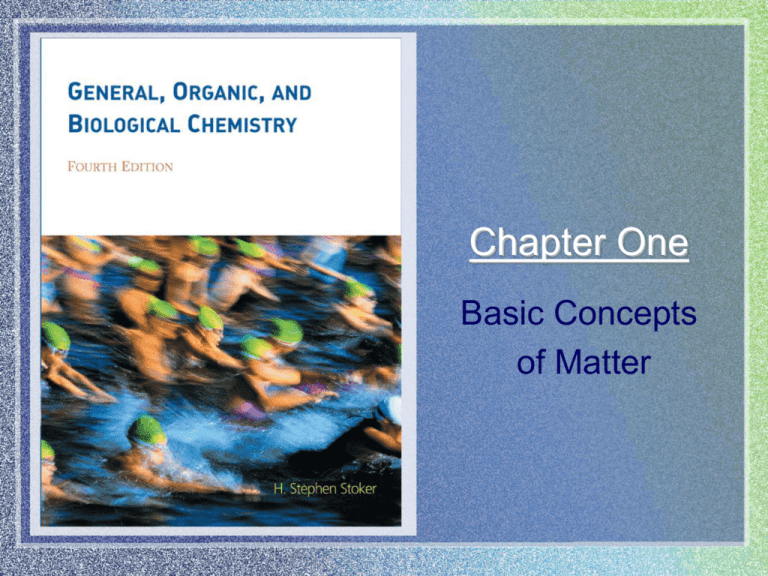
Chapter One
Basic Concepts
of Matter
Basic Concepts of Matter
→ CO 1.1
Volcano Burning
© Gary Braasch/CORBIS
Copyright © Houghton Mifflin Company. All rights reserved.
1|2
Basic Concepts of Matter cont’d
← Fig. 1.1
Solid, liquid, and gas
states
→ Fig. 1.2
Water can be
found in the solid,
liquid, and vapor
(gaseous) forms
simultaneously.
David Schultz/Getty Images
Copyright © Houghton Mifflin Company. All rights reserved.
1|3
Basic Concepts of Matter cont’d
→ Fig. 1.3
The green color of the
Statue of Liberty results
from the reaction of
copper with the
components of air.
Andy Levin/Photo Researchers
Copyright © Houghton Mifflin Company. All rights reserved.
1|4
Basic Concepts of Matter cont’d
C.C. 1.1 "Good" versus "Bad" Properties for a Chemical Substance
Copyright © Houghton Mifflin Company. All rights reserved.
1|5
Basic Concepts of Matter cont’d
← Fig. 1.4
The melting of ice cream is a
physical change involving a change
of state; solid turns to liquid.
Phil Degginger/Color-Pic
Copyright © Houghton Mifflin Company. All rights reserved.
1|6
Basic Concepts of Matter cont’d
→ Fig. 1.5
As a result of chemical
change, bright steel girders
become rusty when exposed
to moist air.
Copyright © Houghton Mifflin Company. All rights reserved.
1|7
Basic Concepts of Matter cont’d
CAG 1.1
Copyright © Houghton Mifflin Company. All rights reserved.
1|8
Basic Concepts of Matter cont’d
Fig. 1.6a
James Scherer
(a) A magnet and a mixture
consisting of potassium
dichromate (orange crystals)
and iron fillings.
Copyright © Houghton Mifflin Company. All rights reserved.
James Scherer
(b) The magnet can be used to
separate the iron fillings
from the potassium
dichromate.
1|9
Basic Concepts of Matter cont’d
Fig 1.7 Matter falls into two basic classes; pure substances and mixtures.
Mixtures, in turn, may be homogeneous or heterogeneous.
Copyright © Houghton Mifflin Company. All rights reserved.
1 | 10
Basic Concepts of Matter cont’d
Fig 1.8 A pure substance can be either an element or a compound.
Copyright © Houghton Mifflin Company. All rights reserved.
1 | 11
Basic Concepts of Matter cont’d
→ Fig. 1.9
Questions used in
classifying matter
into various
categories.
Copyright © Houghton Mifflin Company. All rights reserved.
1 | 12
Basic Concepts of Matter cont’d
CAG 1.2
Copyright © Houghton Mifflin Company. All rights reserved.
1 | 13
Basic Concepts of Matter cont’d
← Fig. 1.10
Outward physical
appearance of
naturally occurring
elements
Copyright © Houghton Mifflin Company. All rights reserved.
1 | 14
Basic Concepts of Matter cont’d
→ Fig. 1.11
Abundance of
elements in the
universe and in
Earth’s crust (in
atom percent)
Copyright © Houghton Mifflin Company. All rights reserved.
1 | 15
Basic Concepts of Matter cont’d
← C.C. 1.2
Elemental
Composition of
the Human Body
Copyright © Houghton Mifflin Company. All rights reserved.
1 | 16
Basic Concepts of Matter cont’d
← Table 1.1
Copyright © Houghton Mifflin Company. All rights reserved.
1 | 17
Basic Concepts of Matter cont’d
← Fig. 1.12
A computer reconstruction of the
surface of a sample of graphite
(carbon) as observed with a scanning
tunneling microscope. The image
reveals the regular pattern of
individual carbon atoms. The color
was added to the image by computer.
Image courtesy of Veeco Instruments Inc.
Copyright © Houghton Mifflin Company. All rights reserved.
1 | 18
Basic Concepts of Matter cont’d
→ Fig. 1.13
254 million atoms
arranged in a straight line
would extend a distance of
approximately 1 inch.
Copyright © Houghton Mifflin Company. All rights reserved.
1 | 19
Basic Concepts of Matter cont’d
Fig 1.14 Molecular structure of (a) chlorine, (b) phosphorus, and (c) sulfur
Copyright © Houghton Mifflin Company. All rights reserved.
1 | 20
Basic Concepts of Matter cont’d
← Fig. 1.15
Depictions of various simple
heteroatomic molecules using
models. Spheres of different
sizes and colors represent
different kinds of atoms.
Copyright © Houghton Mifflin Company. All rights reserved.
1 | 21
Basic Concepts of Matter cont’d
Example 1.2
Classify each of the following molecules as (1) diatomic, triatomic, etc.
(2) homoatomic or heterotomic and (3) representing an element of a
compound.
Copyright © Houghton Mifflin Company. All rights reserved.
1 | 22
Basic Concepts of Matter cont’d
Practice Example 1.2
Classify each of the following
molecules as (1) diatomic, triatomic,
etc. (2) homoatomic or heterotomic
and (3) representing an element of
a compound.
Copyright © Houghton Mifflin Company. All rights reserved.
1 | 23


